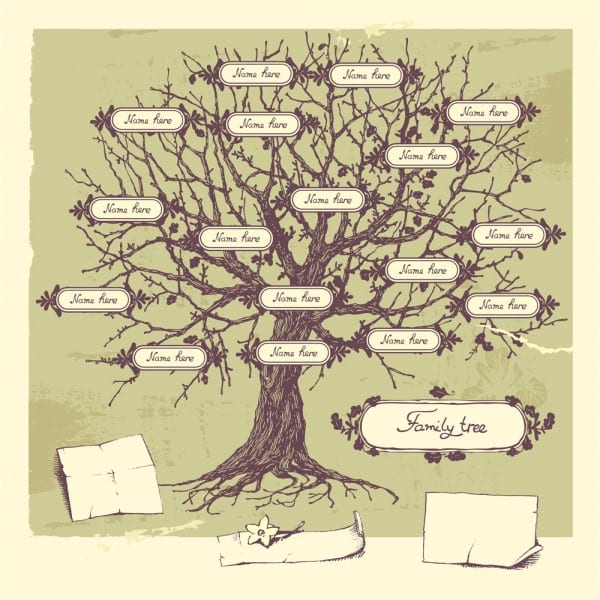Genealogy research and building your family tree is very exciting as you find evidence of your great, great grandparents and more! But all those pieces of paper, all those stories and notes – how can you keep them organized so you can find them? Here is a simple tip for beginners to help keep from being overwhelmed with stacks of papers and various documents.
As you look at your pedigree chart – the bare-bones chart of your direct ancestors – you can see your four grandparents' names and details. When you research for more information, all of these details will fit into one of these four lines of descent. You may eventually have over 8,000 individuals in your family tree, but all these ancestors come out of those four lines of your grandparents. Very handy for organization purposes.
Step 1:
Find yourself four 3-ring binders at your local stationery or office store, in 4 different colors. Use one color for each of your grandparents. If you are just beginning, a 2″ ring is a good size. While you are in the store, check out their supplies of dividers, acid-free paper, acid-free ink pens, and transparent full-size pockets. The pockets will hold your documents, notes, and other research items, including copies of photographs. You may wish to also have one or more high-quality photography albums for your “family tree photo album”, or for scrapbooking the story of your ancestors. The basics, however, are those 4 binders with lots of dividers and pockets, plus acid-free paper.
Step 2:
Label each binder clearly with the family surname of one of the 4 lines. For an example, my grandparents’ surnames are: Gillespie, Bunn, Terwilliger, Kuhn. On the inside cover of the binder, put your pedigree tree, highlighting that family. Or, use the pedigree tree starting at your grandparent, it is your choice. Or, use both: full pedigree from “you” as #1 person, with another pedigree chart starting from “father’s father” as the #1 person. What you are trying to do is to make it quick and easy to see which other families are in this particular family line. Some people buy binders with a clear full-size pocket on the front: slide your pedigree chart into that pocket.
Step 3:
Once you have each binder labelled and with pedigree chart inside, do a Family Group form as the next sheet you will see. On that form, you will have your grandparents, information, their parents’ names and details as well, and their children’s details. These siblings of your parents can be very important for further research as aunts/uncles and cousins may have information you do not have! You may wish to do a Family Group information form for each of the siblings as well. Number and name each sheet so you know how they all relate.
Step 4:
Pop in dividers for each one of the grandparent’s ancestor surnames. For example, my Terwilliger grandparent continues back through the following ancestors: Graves, Ormsbee, Buell, Reid, Bortle, Koen, Buck, Horton, etc. With your pedigree chart at the beginning of the binder, it is clear at a glance how these ancestor lines fit in. Add Family Group forms behind each of the surnames. By the way, as I have several ancestor lines researched back into the 1600s with too many documents for one binder, I separated out several of these lines into their own binders at my 5th-greatgrandparents, to continue the organization of my information on that line. Same color, but labeled as the original grandparent surname and “#2”: e.g., Terwilliger #2, Kuhn #2, etc.
Step 5:
Another divider or two should be put in the binder now for your Sources (copies or originals). You may wish to keep Primary Sources separate from secondary sources, that is entirely up to you. Primary sources are those documents which are filled out or generated at the time of the event: for example, birth certificates are a primary source for birthdate, birthplace, full name of child, names of parents, residence of parents at time of birth. Secondary sources, for example a birth date on a death registration, may not be considered correct since it depends on the knowledge of the person filling in the details. A Census is a very commonly found secondary source. Helpful, and it may support a piece of information allowing you to conclude the accuracy (or not) of that information. Sources are a separate and important subject of discussion which we will leave for another article.
Step 6:
Finally, you may wish to have your Research To Do list in the back of each binder. Others prefer to use a file folder for the Research lists for each family, or for each region of a country. To be most useful, you need a way to keep your future research very accessible, organized, and detailed. Decide on a system for now, and see how it is useful for you. You can always rearrange your Research items in the future.
One last tip:
Do you have too many little bits of notes and post-its around your computer or all over your desk? Organize them into family lines and staple all related ones to a piece of paper, e.g., 6-8 per page. File that paper either in the correct family binder or in your research folder. As you finally get around to checking the information or typing it into your tree, cross off the note with a bright red marker. Once all are crossed off, pull that sheet out and throw it away!
By organizing your information into your four lines of ancestors, you will be saved from those overwhelming stacks of bits and pieces of lost information on your desk, in open boxes, and on the floor! Enjoy your researches!

